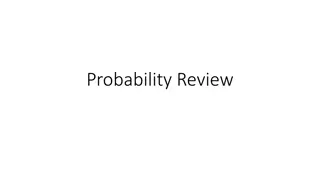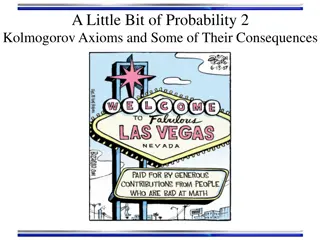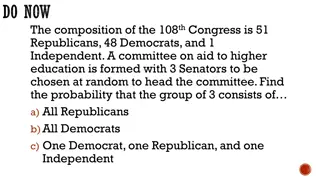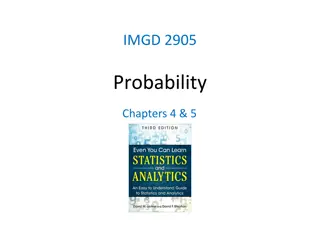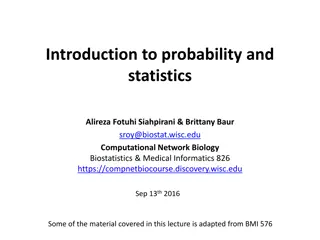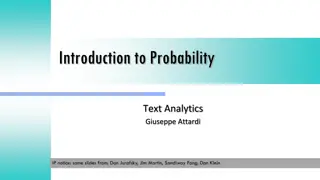Understanding Probability: Theory and Examples
Explore the concepts of probability through the classical theory introduced by Pierre-Simon Laplace in the 18th century. Learn about assigning probabilities to outcomes, the uniform distribution, and calculating probabilities of events using examples like coin flipping and biased dice rolls.
Download Presentation

Please find below an Image/Link to download the presentation.
The content on the website is provided AS IS for your information and personal use only. It may not be sold, licensed, or shared on other websites without obtaining consent from the author. Download presentation by click this link. If you encounter any issues during the download, it is possible that the publisher has removed the file from their server.
E N D
Presentation Transcript
Pierre-Simon Laplace (1749-1827) Probability of an Event We first studied Pierre-Simon Laplace s classical theory of probability, which he introduced in the 18thcentury, when he analyzed games of chance. Here is how Laplace defined the probability of an event: Definition: If S is a finite sample space of equally likely outcomes, and E is an event, that is, a subset of S, then the probability of E is p(E) = |E|/|S|. For every event E, we have 0 p(E) 1. This follows directly from the definition because 0 p(E) = |E|/|S| |S|/|S| 1, since 0 |E| |S|.
Assigning Probabilities Laplace s definition from the previous section, assumes that all outcomes are equally likely. Now we introduce a more general definition of probabilities that avoids this restriction. Let S be a sample space of an experiment with a finite number of outcomes. We assign a probability p(s) to each outcome s, so that: i.0 p(s) 1 for each s S ii. The function p from the set of all outcomes of the sample space S is called a probability distribution.
Assigning Probabilities Example: What probabilities should we assign to the outcomes H (heads) and T (tails) when a fair coin is flipped? p(T) = p(H) = 0.5 What probabilities should be assigned to these outcomes when the coin is biased so that heads comes up twice as often as tails? Solution: We have p(H) = 2p(T). Because p(H) + p(T) = 1, it follows that 2p(T) + p(T) = 3p(T) = 1. Hence, p(T) = 1/3 andp(H) = 2/3.
Uniform Distribution Definition: Suppose that S is a set with n elements. The uniform distribution assigns the probability 1/n to each element of S. (Note that we could have used Laplace s definition here.) Example: Consider again the coin flipping example, but with a fair coin. Now p(H) = p(T) = 1/2.
Probability of an Event Definition: The probability of the event E is the sum of the probabilities of the outcomes in E. Note that now no assumption is being made about the distribution.
Example Example: Suppose that a die is biased so that 3 appears twice as often as each other number, but that the other five outcomes are equally likely. What is the probability that an odd number appears when we roll this die? Solution: We want the probability of the event E = {1,3,5}. We have p(3) = 2/7 and p(1) = p(2) = p(4) = p(5) = p(6) = 1/7. Hence, p(E) = p(1) + p(3) + p(5) = 1/7 + 2/7 + 1/7 = 4/7.
Probabilities of Complements and Unions of Events Complements: still holds. Since each outcome is in either E or , but not both, Unions: also still holds under the new definition.
Combinations of Events Theorem: If E1, E2, is a sequence of pairwise disjoint events in a sample space S, then see Exercises 36and37for the proof
Conditional Probability Definition: Let E and F be events with p(F) > 0. The conditional probability of E given F, denoted by P(E|F), is defined as: Example: A bit string of length four is generated at random so that each of the 16 bit strings of length 4 is equally likely. What is the probability that it contains at least two consecutive 0s, given that its first bit is a 0? Solution: Let E be the event that the bit string contains at least two consecutive 0s, and F be the event that the first bit is a 0. Since E F = {0000, 0001, 0010, 0011, 0100}, p(E F)=5/16. Because 8 bit strings of length 4 start with a 0, p(F) = 8/16= . Hence,
Conditional Probability Example: What is the conditional probability that a family with two children has two boys, given that they have at least one boy. Assume that each of the possibilities BB, BG, GB, and GG is equally likely where B represents a boy and G represents a girl. Solution: Let E be the event that the family has two boys and let F be the event that the family has at least one boy. Then E = {BB}, F = {BB, BG, GB}, and E F = {BB}. It follows that p(F) = 3/4 and p(E F)=1/4. Hence,
Independence Definition: The events E and F are independent if and only if p(E F) = p(E)p(F). Example: Suppose E is the event that a randomly generated bit string of length four begins with a 1 and F is the event that this bit string contains an even number of 1s. Are E and F independent if the 16 bit strings of length four are equally likely? Solution: There are eight bit strings of length four that begin with a 1, and eight bit strings of length four that contain an even number of 1s. Since the number of bit strings of length 4 is 16, p(E) = p(F) = 8/16 = . Since E F = {1111, 1100, 1010, 1001}, p(E F) = 4/16=1/4. We conclude that E and F are independent, because p(E F) =1/4 = ( ) ( )= p(E)p(F)
Independence Example: Assume (as in the previous example) that each of the four ways a family can have two children (BB, GG, BG,GB) is equally likely. Are the events E, that a family with two children has two boys, and F, that a family with two children has at least one boy, independent? Solution: Because E = {BB}, p(E) = 1/4. We saw previously that that p(F) = 3/4 and p(E F)=1/4. The events E and F are not independent since p(E) p(F) = 3/16 1/4= p(E F).
Pairwise and Mutual Independence Definition: The events E1, E2, , En are pairwise independent if and only if p(Ei Ej) = p(Ei) p(Ej) for all pairs i and j with i j n. The events are mutually independent if whenever ij (j {1,2, ., m}) are integers with 1 i1 < i2 < < im nand m 2.















